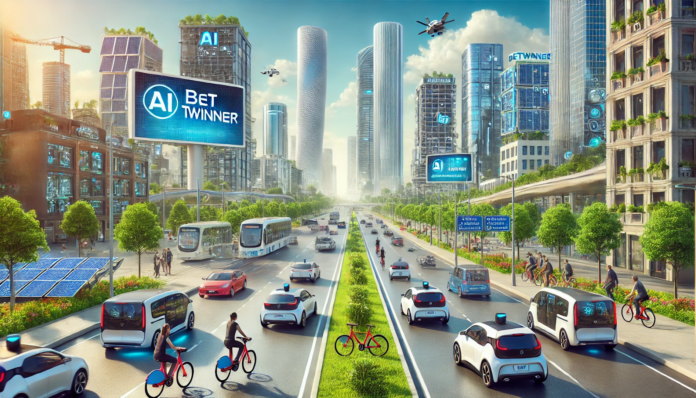The evolution of smart cities is transforming the way we navigate urban environments. Artificial Intelligence (AI) plays a key role in making cities more efficient, sustainable, and citizen-centric. For instance, whether it’s optimizing public transportation, managing traffic, or providing seamless travel experiences, AI-driven smart cities are redefining modern urban landscapes. Want to explore another exciting tech innovation? Check out this guide on how to win Aviator game.
AI’s Impact on Urban Mobility and Travel
Cities worldwide are rapidly adopting AI technologies to improve transportation and reduce congestion. According to recent estimates, urban areas could see a 15% reduction in traffic through AI-powered traffic management systems. Additionally, 38% of citizens have expressed a willingness to give up personal cars for AI-based shared mobility solutions. These smart services—like self-driving cars, ride-sharing, and bike-sharing—offer eco-friendly alternatives that ease pressure on roads and reduce pollution.
Some real-world examples illustrate the success of AI in urban transport:
- Singapore’s “Ask Jamie” chatbot: This AI tool assists citizens with travel-related inquiries, enhancing the efficiency of public services.
- Pittsburgh’s SURTRAC system: By using AI, the city optimizes traffic lights, reducing wait times by over 40%, which leads to smoother travel.
Key Technologies Driving Smart Travel
Several AI technologies underpin the seamless travel experience in smart cities. These tools optimize everything from traffic flow to public safety and resource management. Some of the critical areas where AI makes an impact include:
- Traffic management: AI analyzes traffic patterns in real-time, adjusting traffic signals and rerouting vehicles to prevent congestion.
- Public transportation: AI helps city planners coordinate bus and train schedules more efficiently, predicting demand based on historical and real-time data.
- Mobility as a Service (MaaS): AI-driven platforms integrate various modes of transport—like buses, ride-sharing, and bikes—into a unified app, offering users personalized travel recommendations.
- Smart parking systems: AI-guided parking solutions help drivers find available spots, reducing time spent searching for parking.
The integration of these technologies leads to a significant reduction in travel times, making daily commuting much more efficient.
Environmental Benefits and Sustainable Travel
AI also plays a vital role in supporting sustainability initiatives in cities. With the rise of electric vehicles and renewable energy integration, smart cities are becoming greener. AI optimizes energy usage by adjusting traffic lights, powering public transportation, and reducing waste in city services like water and waste management. By using smart grids and renewable energy sources, cities can cut their carbon footprints by as much as 25% in the next decade.
Some sustainable travel trends shaping 2024 include:
- Electric vehicles (EVs): AI facilitates the transition to EVs by managing charging networks and reducing energy consumption.
- Bike-sharing systems: These systems, often AI-driven, encourage short-distance travel without the need for personal vehicles.
- Public transit optimization: AI reduces energy consumption in buses and trains by adjusting routes based on passenger demand.
Challenges in AI-Powered Smart Cities
Despite the promising potential, smart cities face challenges in fully utilizing AI. Data management remains a top concern, with over 73 zettabytes of data expected to be generated by 2025 from IoT devices alone. Managing and processing this data is crucial for AI to deliver actionable insights. Additionally, ethical concerns around privacy and data security are prevalent, particularly when it comes to the tracking and monitoring necessary for AI systems to function effectively. To address these issues, collaboration between public and private sectors is critical.
FAQ: Smart Cities and AI in Travel
What is a smart city?
A smart city uses advanced technologies like AI and IoT to enhance urban life by improving transportation, reducing waste, and optimizing resource management.
How does AI improve public transportation?
AI uses data from IoT sensors to analyze demand and traffic, allowing public transport systems to run more efficiently and reduce wait times.
What are the environmental benefits of AI in cities?
AI helps reduce energy consumption, manages waste more effectively, and supports the integration of renewable energy, contributing to lower emissions.
Are there challenges to implementing AI in cities?
Yes, data management, privacy concerns, and regulatory hurdles are significant challenges. Collaboration between stakeholders is necessary to overcome these.
How do smart cities benefit travelers?
Smart cities enhance travel experiences by reducing congestion, offering seamless transport options, and personalizing travel routes through AI-powered apps.
In conclusion, smart cities, powered by AI, are transforming urban mobility and making travel more efficient, sustainable, and convenient. As the world moves toward greener, more connected urban spaces, the role of AI will only expand. For more on how these technologies are reshaping cities, you might also want to check out the Wikipedia article on Smart Cities for further reading.
These AI-driven innovations are not just improving travel but also paving the way for more liveable, resilient urban environments.


